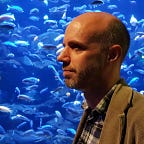‘Bandits of Orgosolo’ or — The Most Exciting Sheep-Herding Movie Ever Made?
A film about Sardinian shepherds herding sheep might not sound like the most thrilling concept for a movie but Vittorio De Seta’s ‘Bandits of Orgosolo’ (1961) is not only exactly that but is also one of the most visually arresting movies I’ve seen. I’ve the hunch we’re dealing with a masterpiece here, folks.
Michele, an impoverished shepherd (is there any other kind?), finds himself an inadvertent suspect to the authorities after three bandits he reluctantly gave shelter to the previous night shoot dead a policeman. Not trusting the legal system to believe his story Michele, along with his younger brother Peppeddu, flees into the barren and inhospitable landscape of the surrounding Barbagia countryside to escape the enclosing forces, something made significantly harder by the fact they have to take their flock (all with loudly clanging bells round their necks) with them as these precious sheep are all they have. In short, if the sheep die so does Michele’s future and his only remaining option will be to become the very thing that put him in this position in the first place.
De Seta’s film stems directly from the Neorealist cinema that sprang from Luchino Visconti’s ‘La Terra Trema’ (1948) although with some big (and more successful) differences, the main one being De Seta takes the detached view of an egoless observer as opposed to Visconti who attempted to force his operatic will onto the very spectacle of nature itself (it must’ve been gruelling enough being an impoverished anchovy fisherman let alone having to also BE in a Visconti movie to boot). De Seta also forgoes the more analytical and interpretive approach of, say, Francesco Rosi to his subject matter so, instead, the camera simply follows rather than probes.
The shepherds are all played by real Sardinian sheepherders (although Michele’s voice was later dubbed by Gian Maria Volonté for technical reasons but also because I suspect acquiring finely honed acting skills wasn’t really a priority for penniless Sardinian sheepherders) and the Sardinian environment is truly theirs with De Seta only providing a minimal story outline and suggested directions. And then we do nothing but watch.
Michele might know this land intimately but his predicament appears futile as the State intrudes and exerts its power where it doesn’t belong, or is even recognised, meaning the Carabinieri might as well be an occupying military force. It doesn’t matter to this remote region of the South if it’s the Nazis, fascists or democratic Italians in power as the effect on them is still the same — destruction, repression and the total annihilation of their way of life. The only effects here of the remote Economic Boom are its lethal blast waves. So the plot might be simple but the message is undeniable, and once Michele and Peppeddu set out with their flock the tension goes through the roof (it’s like Clouzot’s ‘The Wages of Fear’ meets the old BBC show ‘One Man and His Dog’ only these poor sods don’t even have a dog).
This gives De Seta’s film a ferocious immediacy and this taut grasp combined with his anthropological stance means he has slightly less in common with Visconti or Rossellini and more with Japan’s Shōhei Imamura or even the British filmmaker who would develop this style to commercial success years later, Paul Greengrass.
Yet what’s most mesmerising about the film is the cinematography, much of it captured by De Seta himself, which is, quite frankly, jaw-droppingly astonishing. Vertiginous cliffs, plummeting ravines, endless oceans of rocks, mountainous clouds — this isn’t just a film where the landscape is, to quote the cliché, a character itself but more an all consuming force within which these people exist before ultimately returning.
De Seta himself said that whilst filming a volcanic eruption on Sicily for his documentary short ‘Islands of Fire’ (1955) that he had no idea if any of his footage would be usable let alone of any artistic quality, but when he eventually saw the dallies he broke down in tears at the sheer beauty at what he had captured. And for bloody good reason because ‘Islands of Fire’ contains footage of the natural world so astounding it defies description and would reduce anyone to tears who witnesses it. And ‘Bandits of Orgosolo’ is just as eye-boggling.
As a Neorealist film about a man and a younger kid struggling against a shifting and changing world I think De Seta’s film might, just might, be even better than De Sica’s ‘Bicycle Thieves’ (1948). It’s captivating, perfectly balanced and immensely powerful. It’s also one of the most beautiful black and white movies ever made.
As I said, I suspect we’ve been dealing with a masterpiece here.
